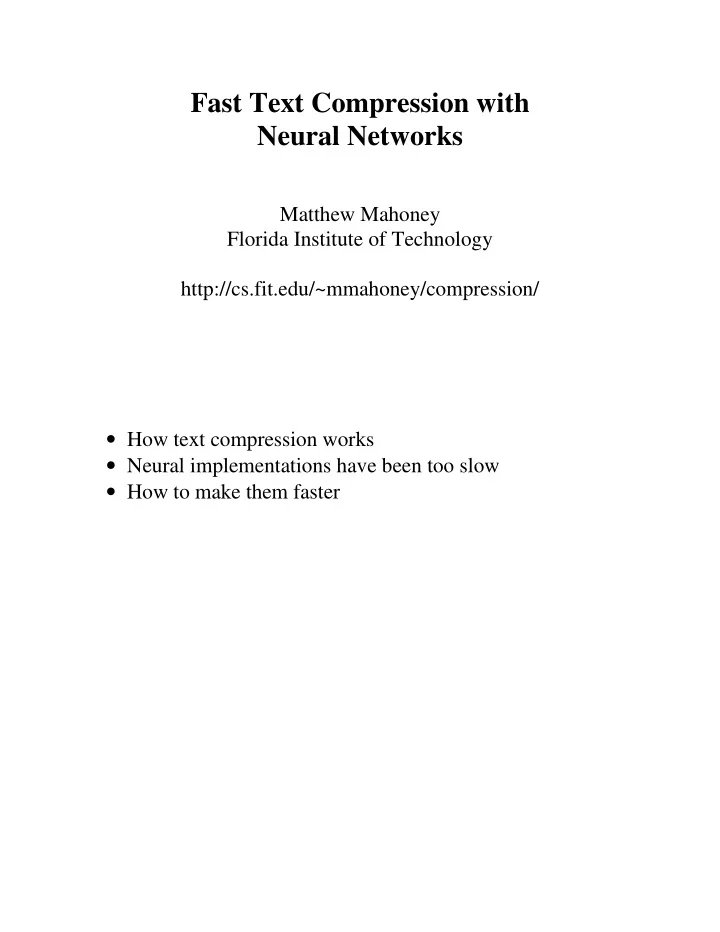

Fast Text Compression with Neural Networks Matthew Mahoney Florida Institute of Technology http://cs.fit.edu/~mmahoney/compression/ • How text compression works • Neural implementations have been too slow • How to make them faster
How Text Compression Works Common character sequences can have shorter codes Morse Code e = . z = --.. Shorter code Longer code e z dog dgo of the the of roses are red roses are green Text compression is an AI problem
Types of compression From fast but poor... to slow but good Limpel-Ziv ( compress, zip, gzip, gif ) the cat in the hat the cat in h Context Sorting ( Burrows-Wheeler (szip) ) the ca|t ---> 2t 1a 2_ 2e ( run-length code ) the ha|t the c|a in the|_ at the|_ in th|e hat th|e Predictive Arithmetic ( PPMZ (boa, rkive) and neural network ) P( a ) P( b ) x = the ca P(x ≤ the cat) Predictor Arithmetic Encoder P( z ) t
Arithmetic Encoding 0 1 A |B| C | D | E |F|G| H |I |J|K| L | M | N | O |P |Q|R | S | T | U|V|W|X|Y|Z .78 .83 TA |||| TE || TH | TI ||||| TO || TR | TU | TW|TY .795 .798 .803 .81 THA |||| THE |||| THI ||||| THO || THR || THU ||| P("THE") = 0.005 Compress("THE") = .8 Binary code for x is within 1 bit of log 2 1/P( x ) (Theoretical limit, Shannon, 1949) Compression depends entirely on accuracy of P.
Schmidhuber and Heil (1994) Neural Network Predictor A A A A A A B B B B B B C C C C C C Z Z Z Z Z Z Last 5 Next characters Character • 80 character alphabet • 3 layer network • 400 input units (last 5 characters) • 430 hidden units • 80 output units • Trained off line in 25 passes by back propagation • Training time: 3 days on 600KB of text (HP-700) • 18% better compression than gzip -9
Fast Neural Network Predictor X i N 01 E|L|E|P|H|A|N| 01 AN 01 y P(1) HAN 01 22-bit hash PHAN 01 function W i , N i (0), N i (1) EPHAN 01 • Predicts one bit at a time • 2 layer network • 2 22 (about 4 million) input units • One output unit • Hash function selects 5 or 6 inputs = 1, all others 0 • Trained on line using variable learning rate • Compresses 600KB in 15 seconds (475 MHz P6-II) • 42-47% better compression than gzip -9
Prediction P(1) = g( Σ i w i x i ) Weighted sum of inputs g(x) = 1/(1 + e − x ) Squashing function Training N i (y) ← N i (y) + x i Count 0 or 1 in context i E = y − P(1) Output error w i ← w i + ( η S + η L / σ 2 i )x i E Adjust weight to reduce error σ 2 i = (N i (0) + N i (1) + 2d)/(N i (0) + d)(N i (1) + d) Variance of data in context i d = 0.5 Initial count η S = 0 to 0.2 Short term learning rate η L = 0.2 to 0.5 Long term learning rate
Compression Results compress compress zip zip gzip -9 gzip -9 szip -b41 -o0 szip -b41 -o0 boa -m15 boa -m15 rkive -mt3 rkive -mt3 Book1 Alice p5 p5 p6 p6 p12 p12 0 0.5 1 1.5 2 2.5 3 3.5 Compression in bits per character • η S and η L tuned on Alice in Wonderland • Tested on book1 (Far from the Madding Crowd) • P5 - 256K neurons, contexts of 1-4 characters • P6 - 4M neurons, contexts of 1-5 characters • P12 - 4M neurons, contexts of 1-4 characters and 1-2 words (unpublished)
Compression Time compress compress zip zip Decompress gzip -9 gzip -9 Compress szip -b41 -o0 szip -b41 -o0 boa -m15 boa -m15 rkive -mt3 rkive -mt3 p5 p5 p6 p6 p12 p12 0 20 40 60 80 100 120 140 Seconds to compress and decompress Alice (152KB file on 100 MHz 486)
Summary Compression within 2% of best known, at similar speeds 50% better (but 4x-50x slower) than compress, zip, gzip Fast because • Fixed representation - only output layer is trained (5x faster) • One pass training by variable learning rate (25x faster) • Bit-level prediction (16x faster) • Sparse input activation (5-6 of 4 million, 80x faster) Implementation available at http://cs.fit.edu/~mmahoney/compression/
Recommend
More recommend